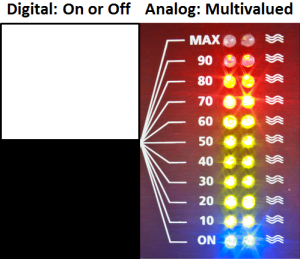28 Mar Is Everything Black or White?
 We have exercised our abstract ideas about that which is too big and chaotic for us to understand (everything), let’s take a glimpse at that which is so small and chaotic that we may never really figure it out: the workings of the mind. In the next few posts, we will examine different forms of logical thinking. The differences in the types of logic will provide clues to how we can build computing systems that mimic the logical processes of human reasoning.
We have exercised our abstract ideas about that which is too big and chaotic for us to understand (everything), let’s take a glimpse at that which is so small and chaotic that we may never really figure it out: the workings of the mind. In the next few posts, we will examine different forms of logical thinking. The differences in the types of logic will provide clues to how we can build computing systems that mimic the logical processes of human reasoning.
The electrical flow of excitation and inhibition in the brain is not digital. There are no logical zeros or ones in or between neurons. Different levels of impulses may produce different cognitive outcomes. Thus, as we seek suitable process and knowledge models for building these computing systems, we are best served by adopting flexible models.
Logical thinking is also called inference. Inference is based on rules. These rules are the subject of I’d like to pursue for awhile. Typically this type of rules are based on logic that can be divided into two categories: binary and multi-valued logic.
| Understanding Context Cross-Reference |
|---|
| Click on these Links to other posts and glossary/bibliography references |
|
|
|
| Prior Post | Next Post |
| Cognition and Emotion | Is Anything True or False |
| Definitions | References |
| abstract chaotic syllogism | Robot Neurons Calvin 1996 |
| understand logic | Dichotomy vs. Continuum |
| flip-flop reasoning | Context of Knowing Thinking and Believing |
| modus ponens modus tollens | Valiant 1994 |
Binary Logic: Two-valued or dichotomous logic deals with True and False values without anything in between. Digital logic is the kind computers use and it is binary. It is implemented in silicon chips that contain registers and memory bits that each may hold an electric charge assigned the value of zero (0) or an electric charge assigned the value of one (1). A single register or bit in a computer, therefore, could represent the idea that the thing it is bound to is TRUE (1) or FALSE (0).
Multi-valued Logic: Scales of belief, confidence, or truth are applied to declarations or logical propositions to express their likelihood, credibility or probability. We will look into this more in future posts, but for now, let’s establish that two-valued logic has an important place in our model.
Dichotomous Logic
If we assume that a statement is either true or false, we can use dichotomous or two-valued logic to develop a theorem to prove it. This is an intuitively easy approach, particularly for computers that prefer exactly two options that can be represented with 1 or 0. The standard theorems for proving dichotomous statements are well known and well exercised. Some are stated at left. For statements with relatively absolute truth values, dichotomous logic is extremely useful. Since most computers are based on binary (digital) logic, the functions associated with Aristotelian logic are quite useful.
If we write a program for a digital computer, we must eventually break down the functions to a sequence of actions based on branching instructions. Here is an example of a proposition based on true/false logic:
IF a AND (b OR c) THEN d
Premise 1: a = Subject is a person AND
Premise 2: b = Subject was born in country OR c = Subject has completed naturalization procedures
Conclusion: d = Subject is a citizen
This is a defensible proposition, although perhaps not universally true. Any well-formed proposition, true or false, will stand the test of logic if it does not produce a contradiction.
 The proposition above is a syllogism: a proposition with two premises and a conclusion. There may appear to be three premises in the proposition above, but our use of parentheses combines the second and third premise into one for convenience. By the way, this convenience function “flattens” out the problem by reducing it to two dimensions. Flattening out multi-dimensional problems is the only way for digital computers to handle them. The words AND and OR are logical connectives that form a conjunction and a disjunction. In logic, as in mathematics, we resolve the parenthetical phrases first, so we would find out first if b OR c were true, then resolve a. The fact that citizenship may be revoked creates an exception to the rule. There may also be countries in which citizenship is more or less strictly defined. So the validity of the logical proposition may change based on context (please recall the case of Air France Flight 447 and the implications of one false assumption – see my post on Bayes and Search).
The proposition above is a syllogism: a proposition with two premises and a conclusion. There may appear to be three premises in the proposition above, but our use of parentheses combines the second and third premise into one for convenience. By the way, this convenience function “flattens” out the problem by reducing it to two dimensions. Flattening out multi-dimensional problems is the only way for digital computers to handle them. The words AND and OR are logical connectives that form a conjunction and a disjunction. In logic, as in mathematics, we resolve the parenthetical phrases first, so we would find out first if b OR c were true, then resolve a. The fact that citizenship may be revoked creates an exception to the rule. There may also be countries in which citizenship is more or less strictly defined. So the validity of the logical proposition may change based on context (please recall the case of Air France Flight 447 and the implications of one false assumption – see my post on Bayes and Search).
Two-Valued logic is flat and easy for computers to process using “branching” logic (In case the value is 1 branch left, in case the value is 0, branch right). So no matter how limited black and white are, there is a place for two-valued logic in our model for smarter computers.
| Click below to look in each Understanding Context section |
|---|
| Intro | Context | 1 | Brains | 2 | Neurons | 3 | Neural Networks |
| 4 | Perception and Cognition | 5 | Fuzzy Logic | 6 | Language and Dialog | 7 | Cybernetic Models |
| 8 | Apps and Processes | 9 | The End of Code | 10 | Glossary | 11 | Bibliography |









